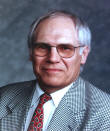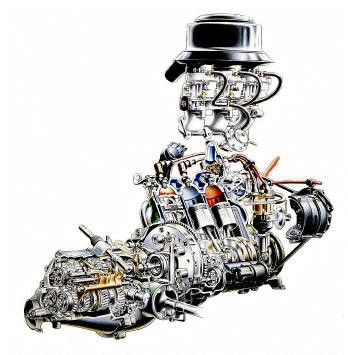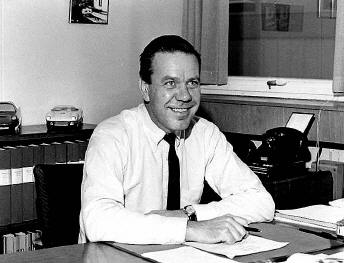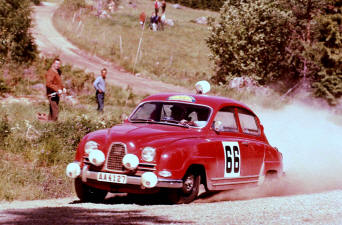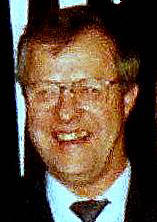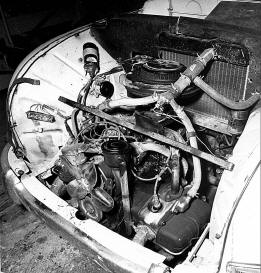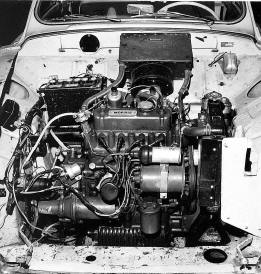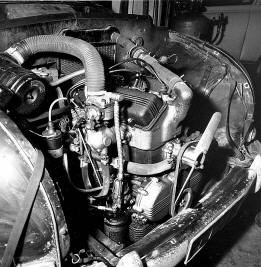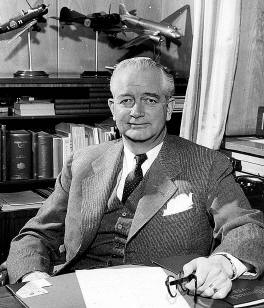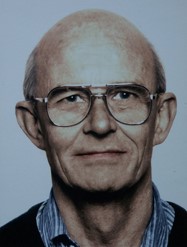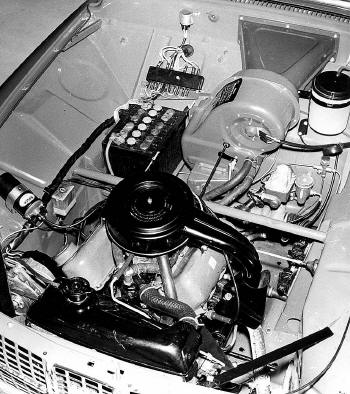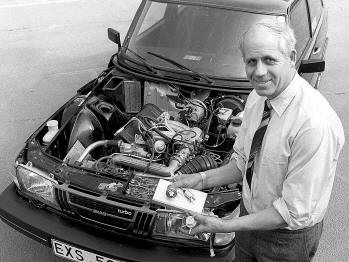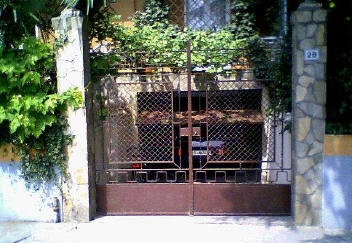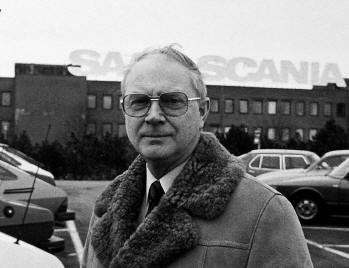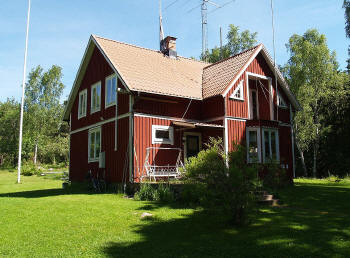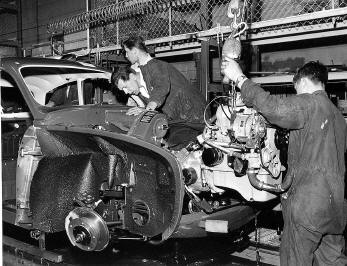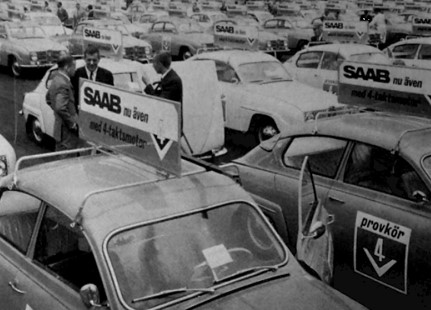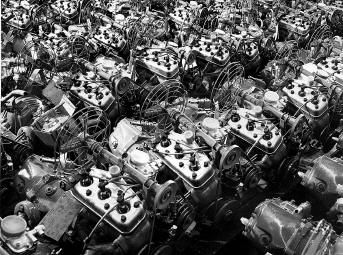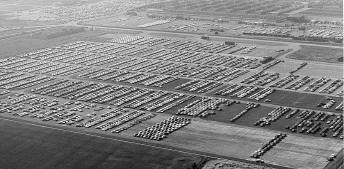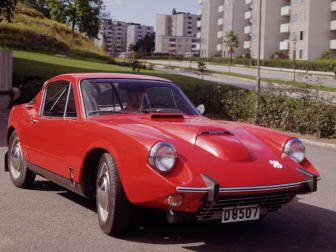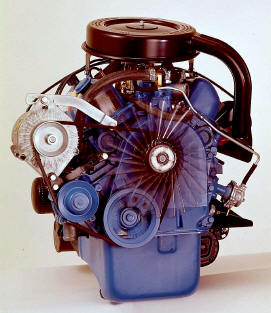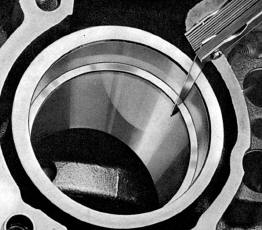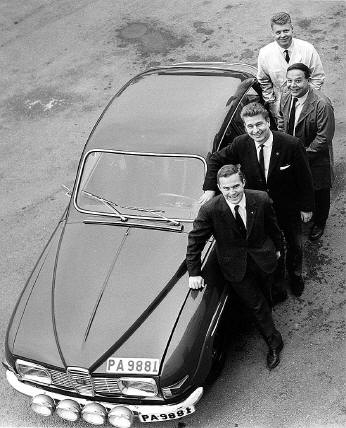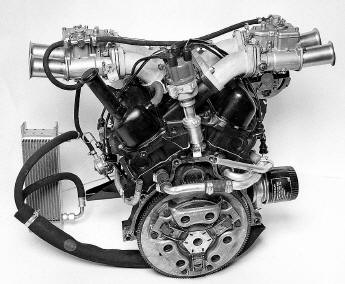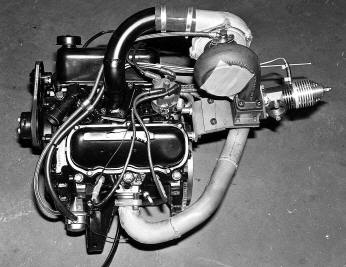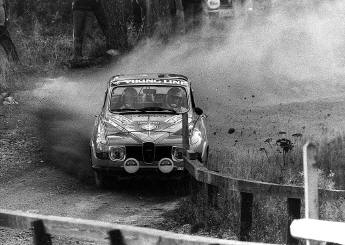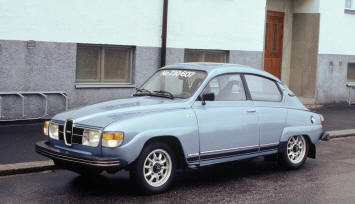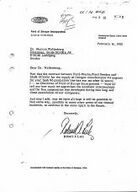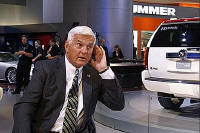The introduction of the 4-stroke engine in the Saab 95/96/Sonett
Written by Olle Granlund, Test and development manager at Saab's engine laboratory, in Trollhättan
Innehåll
Introduction
During the early 1960s, the Saab factory was running at full speed and sales of the Saab 95/96/Sonett increased, on average, by about 10% per year.
Competition between car manufacturers also increased with new cars, similar in size to the Saab 96 being introduced by Volkswagen, Volvo (444), Opel, Fiat and from the English car manufacturers Triumph and Morris etc.
In 1966, Saab introduced a modified two-stroke engine with higher performance. The engine had 3 carburettors and to reduce smoke, a common complaint from many owners of earlier cars with 2-stroke engines, the fuel/oil mixture ratio was lowered from 3% to 1.5%.
Two-stroke engine with 3 carburettors
An important factor, affecting sales, was the engines increased fuel consumption. Many customers considered this totally unacceptable and sales of new cars fell by approx. 30% in Saabs important home market. Annual sales dropped from a total of 48 500 cars in 1965, to 37 000 cars, in 1966.
Saab's Management was naturally very concerned. Technical development manager Rolf Mellde was fully aware that something very radical had to be done to get Saab quickly out of what was becoming a very serious problem for the company.
Rolf Mellde
Rolf Mellde was convinced that Saab's 2-stroke days were limited and a more modern, cleaner and fuel efficient 4-stroke engine was needed. Saabs 2-stroke engine which had provided the power to gain many rallying successes throughout the world, no longer attracted customers in what was becoming a much more tougher market segment for SAAB to operate in.
Saab on its way to another rallying success
During 1962-1964 Saab made several preliminary studies using 4-stroke engines. Kjell Knutson and mechanic, Ingvar Andersson, performed many tests with different 4-stroke engines installed in the "short nose" version of the Saab 96. Restricted space in the engine compartment often made installations difficult to complete.
Kjell Knutsson
Three different installations were however made and are shown below:
Lloyd Arabella engine of 897 cc and 45 hp. Lloyd engines were used by Borgward, who had gone into liquidation in 1961 but continued to be built until 1963.
Morris Mini Minor engine, 848 cc and 33 hp. This was a transverse installation of the complete drive train with the gearbox mounted inside of the engine's crankcase.
Lancia Appia engine of 1089 cc and 48 hp. This engine was of a V formation with a 10° angle between cylinder banks, it had a common cylinder head and two low-positioned camshafts. This engine was claimed to be of modern design with its cylinder block, cylinder head and oil pan made in aluminum.
Despite the limited space in the engine compartment the installations were successfully completed. This naturally pleased Rolf Mellde and further strengthened his ambition to introduce a 4-stroke engine. Unfortunately, due to differing points of view within Saabs management staff, the 4-stroke plans were not fully accepted. Managing director Tryggve Holm later cancelled all further work on the project.
Tryggve Holm, Saab's Managing Director
More determined, Rolf secretly, took contact with Marc Wallenberg, the son of Saabs most prominent shareholder, Marcus Wallenberg. This was a huge risk for Rolf to take acting on his own and without informing his immediate superiors.
Marc Wallenberg and his father however agreed that a new 4-stroke engine was needed. After a few days, Tryggve Holm contacted Rolf and informed him to immediately resume work on the 4-stroke project.
Rolf Mellde had succeeded. In retrospect one can only speculate that had it not been for Rolf Melldes strong determination, Saab might not have survived what was developing into a crisis for the company.
Tryggve Holm however ordered that production of the 2-stroke engine should nevertheless continue to be built for a further 5 years in the new engine plant in Gothenburg.
The start of the 4-stroke era
Per Gillbrand, and myself Olle Granlund, had earlier worked together at Volvo's engine laboratory in Gothenburg. In the summer of 1964, Per left Volvo to start work at Saab in Trollhättan. I later followed him and on the 1st of February 1965, I clocked in at my new workplace.
My immediate boss was Josef Eklund, the manager of Saab's engine laboratory. I shared office with Per Gillbrand and my first assignment was to perform a series of long-term endurance tests with different 4-stroke engines.
As Saab had little experience of 4-stroke engines, Rolf Mellde ordered that test data from well-known engine manufacturers should be derived. This data was needed as a reference when deciding final engine design specifications. Items of specific importance were oil and fuel consumption and component durability.
The test beds at Saab, being originally designed for testing two-stroke engines, needed to be extensively modified. Equipment for engine cooling and the calculation of oil and fuel consumption data etc. needed to be installed. Engines that were tested were the Volvo B18, Ford V4, Triumph 1300, Lancia V4, Opel, Volkswagen and the Hillman Imp.
The Volvo engine performed best, and became the projects benchmark. The Ford V4 was almost equally as good, performing well during most of the test work.
Parallel to the dyno-tests a Ford V4 and a Triumph engine were installed in Saab 96´s. Modifications were needed to be made to certain components i.e. the flywheel housing, exhaust, throttle linkage, cooling system etc. Lennart Rosen, was the designer responsible for engineering drawings etc.
Lennart Rosén
The most suitable engine, and easiest to install in the 96 was the Ford V4. This engine was very compact, and left sufficient space in the Saab 96´s engine compartment for the cooling fan, water pump and alternator etc.
The engine compartment of the 96 with its V4 engine
It is of interest to point out here that the Ford V4 engine was originally developed in the USA. Ford, together with many other manufacturers, were being affected by the fuel crisis and had intended launching a small economical car code named "Cardinal".
After a few years of development, the project was cancelled and the fully developed engine was transferred to Ford's European subsidiary in Cologne, Germany. In 1962, this engine was introduced in the Ford Taunus 12M.
Interestingly, I learned later that Ford had planned to perform a series of tests in the USA with the Saab 96 and had purchased 20 new cars from a private Saab dealer in Dearborn, Michigan. From this we can maybe assume that the Cardinal project was intended for a front wheel drive car, probably the same size as the Saab 96? As soon as the V4 engine was selected to be used by Saab the circle of events became finally closed.
Recently, I received an interesting letter from an American journalist who´s colleague, some 20 years ago, visited a car scrap-dealer on the outskirts of Detroit. Well-hidden, he noticed a short nose Saab 96 with a V4 engine installed – could this have been one of Ford's original test cars?
Work in the engine test laboratory progressed according to plan and a lot of important data was collected from long-term durability tests which often took 400 or more hours to complete. City and high speed motorway driving cycles were also included in the test cycles.
In 1965 with all test data completed Rolf Mellde decided that the Ford V4 engine would be the best engine to be used in the Saab 96. Ford in Detroit was later contacted to discuss purchasing arrangements etc.
Not disclosing his plans for Saab's management, Rolf travelled to the United States with the intention of participating in a SAE conference. Once in Detroit he met with Robert McNamara, Fords CEO and Don Fray the director of Ford US operations. The purchase of V4 engines was discussed and these two men were positive towards working together with Saab and the purchase of V4 engines.
With the approval of Ford in the USA, Rolf Mellde started subsequent negotiations with Ford's top management in Europe which resulted in Ford's European Director, Harold Jones signing a 5-year contract. Fords director Rune Svensson was also present, during negotiations etc. To maintain a high secrecy level and to avoid any connections between Ford and Saab the V-4 project was given the code name "Kaisa" - the name of Rune Svenson’s wife. At that time only 3-4 Saab employees were involved in the project.
Further negotiations over the coming years relating to costs, quality, etc., was supervised by Ford's European Industrial Engine division based in Basildon, England. Technical support came also from Ford's local office in Stockholm via Lars Engström.
In early February 1966 Per Gillbrand informed me that he intended to take a few months off work and help manage his father's paint shop in Tidaholm. This puzzled me very much. I found it very difficult to believe that Saab´s Turbo genius, Per Gillbrand could even consider such a move?
Per did eventually leave his job though and together with his wife Inga and son Peter made tracks for Tidaholm?
As we lived close to each other; our boys often played together, the family gave us no indication that the move wasn’t true.
Per Gillbrand
What happened though, and which I had suspected from the start, was that Per Gillbrand had driven to Northern Italy with his family to Desenzano, located at the southern side of Lake Garda. Here, Per had rented a garage from Giacomo Acerbi on the corner of Via Sirmione 28 and Via Gambotti and was where he worked for several months performing long-term durability tests with one of the first Saab 96`s with a V4 engine from Ford.
Per's garage at Via Sirmione 28
To achieve maximum curb weight of the car, he purchased several sacks of cement from a local building supplier-with the weight noted on each sack. Once the car had been loaded Per started his test drive; In the morning, it consisted mainly of highway driving and in the afternoon, it was on mountain roads where he could put the car through as much varied driving conditions as possible. After the day's driving, generally accumulating 800+ km, it was time for an inspection and service. Per Gillbrand´s landlord was a very curious man– he wondered, quite rightly, just what was going on with a car that required so much service needing to be done every day? The building supplier was even more surprised when, after several months, Per returned wanting to return the sacks of cement? They must have thought that these Swedes were very strange people indeed?
Work in Trollhattan continued as normal and no-one suspected just what was going on?
On a Wednesday in early April 1966, I was called into Rolf Mellde´s office where he informed me of the plans to start producing the Saab 96 with a Ford V4 engine. This was to take place in 5 months’ time, directly after Saab's industrial vacation. I was given a list of 7 people who were aware of the project and he instructed me not to reveal anything to anybody, not even to my wife and family.
The list of names included Svante Holm, the CEO of Saab, Rolf Mellde, Technical Director, Haakon Sörgardt, Purchasing Manager, Rune Ahlberg, Manager of the Kristinehamn factory (where plastic parts were manufactured) and Per Gillbrand, Kjell Knutsson and Lennart Rosen, all from technical departments.
Rolf Mellde's information was clear and concise. He informed me that I was required to stop working with all my current assignments, and notify my supervisor Josef Eklund, (who was not informed), that as from Monday, I needed to take leave of absence!
He told me that on Monday morning I was required to drive the large Dodge van, parked at the technical department, and drive to the Ford plant in Cologne, pick up 5 V4 engines and deliver them to the Saab factory in Kristinahamn.
I informed Rolf Mellde that I found it very difficult to go to my boss at such short notice and request leave of absence-his only reply to this was that it was a problem for me to solve!
Early next day, I took a deep breath and courageously stepped into Josef Eklund's office to requested leave of absence. He somehow accepted my request, but replied by saying “Whatever I say doesn´t really matter, you will be on your way on Monday morning in any case", Josef Eklund must have already known what was going on?
The trip down to Cologne went well and three days later I delivered the engines to Kristinehamn. Work started immediately on the installations and after two weeks it was time to return to Cologne to pick up a new supply of engines.
Rune Ahlberg
Rune Ahlberg established quickly the need to have a separate workshop outside the factory gates where staff could work undisturbed, modifying vehicles. An office was also needed for administrative work etc.
Via the local community in Kristinehamn an old timber house (Kroksvik) was found which had originally been used by the social services as a residence for the homeless. The house, to the west of Kristinehamn, needed to be extensively refurbished before anyone could live and work there.
As there was no garage, two new easily assembled garages were ordered and were required to be delivered prior to the winter thaw. Builders arriving to erect the garages wondered just what it was that couldn’t wait until all the winter snow had gone?
The wooden house in Kroksvik
One of the problems with keeping such a large project secret was organizing the purchase of components for the V4 engine. Here Rune Ahlberg and the Kristinehamn plant came into the picture. A company called Machine Tools AB was registered with Rune Ahlberg as the owner which was a clever idea to avoid Saab being identified with the purchases of components etc. Another advantage of working in Kristinehamn was having easy access to engineering workshops and performing machine work when needed.
One such operation concerned the delivery from a company in France who supplied raw castings for the V4 engines flywheel housing. An experienced production technician from Saabs transmission plant in Gothenburg, Gösta Mårtensson, was called to Kristinehamn to prepare and carry out additional machine work.
Saab's purchasing department was completely unaware of what was going on and many incidents occurred. One example was after Rune Ahlberg had taken direct contact with the Liljeholmens cable factory and cancelled all delivery of the Saab 96 engine compartment wiring harness. The delivery inspectors at Saab noticed that deliveries had stopped which prompted purchasing manager, Erik Ekebergh, to later contact the supplier and in strong terms, ordered them to promptly resume delivery!
Work in Kristinehamn progressed and 6 cars were quickly converted. Per Gillbrand returned from Italy taking time to inspect the test car and engine that had completed 48 000 km. The results were good and nothing had emerged from a technical aspect that could jeopardize the project.
An important task was also to provide data for the parts catalogue, workshop manual and the instruction book along with several service tools etc. Despite long working days at Kroksvik time was starting to run short so Saab's service manager David Persson was called in to help me complete the work on time and avoid delaying the project. The Owner´s Manual of the V4 engine was finalized and issued as a supplement to the ordinary user’s manual.
One of my lasting memories of the time in Kroksvik was when I was sitting on the veranda in the small hours and watched as a family of deer came up into the courtyard. They were also inquisitive of what was going on! It was a magnificent sight to see!
Production preparations
The last week in June, immediately before the industrial summer holiday, it was time to spread the word at Saab about the V4 project. The first Saab team that was to be informed consisted of S. Claesborn (production manager), N-G Nilsson (workshop manager), B. Andersson (workshop engineer) and B. Lindberg (foreman final assembly). The team arrived in the morning for a meeting with Rune Ahlberg who had driven directly to Kroksvik by himself.
Two converted 96's were parked in the courtyard without any indication that the cars were fitted with V4 engines. Once the guests had arrived, Rune Ahlberg invited them to open the bonnet of the cars. The visitors were amazed by what they saw, and were impressed by the high degree of quality.
After further information about the project, and what was needed to assemble and install the V4 engine, the next surprise came for the guests - In four weeks’ time, production is required to be converted so that assembly of the SAAB 95/96 with the V4 engine can begin!
There were many who wondered if in fact this project could be fully realized in such short time? Following a test drive and more in-depth information the guests became more aware that the introduction of the V4 engine was critical for the future survival of Saab. Planning for the industrial summer holiday began immediately and since the engine replacement was relatively easy to perform there was no need for any major changes to be made in production.
Many intensive activities were going on within Saabs technical department - A separate workshop was organized including an assembly line where 2-stroke engines could be removed and replaced with the V4- engine.
A V4-engine being installed
During the industrial holiday the target was to build about 200 cars to cover the requirements of the introduction in early August. SAAB dealers in Sweden and journalists from car magazines etc. were invited to drive home from the launch held at Storängsbotten in Stockholm, in a new V4 Saab 96.
Storängsbotten
To have sufficient staff for installing the V4 engines, 40 experienced car builders from production were contacted and told that they were needed to rebuild Saab 96 disc brakes assemblies, and were to be at the factory Monday morning the 4th July, the first week of the Industrial holiday. Getting these people to work through the holiday weeks was not a problem and rebuilding work went quicker as time moved on. When the holiday was over, about 600 cars had been converted. John Åhs, the workshop manager in the engineering department was responsible for staff and time keeping etc. After the industrial holiday rebuilding of the cars continued in one of Saabs large warehouses.
In the autumn, a total of 6 284 cars, parked on a close by air-field, had been modified with V4 engines. The 2-stroke engines, removed from cars were later used as replacement engines by the service department
Removed 2-stroke engines later used by the service dept.
Unsold cars parked at the airport.
Although several people became aware of the V4 project the secret was not leaked to the public until a few days prior to the introduction, a journalist discovered a car transporter loaded with SAAB 96´s with V4 emblems on their front fenders! News quickly spread fast to the public and motoring press.
Then came the big day, 2nd August 1966, when the introduction took place in Storängsbotten. Dealers from all over Sweden came to the launch and after Rolf Mellde had given introductory informatory the dealers etc. were given keys and could drive away in a brand new V4 Saab 96. All cars performed perfectly and many positive reviews were received by the company. The launch had been a total success!
Rolf Mellde and the rest of the management were relieved, from losing ground in the Swedish new car market Saab could now look to the future with confidence. Many positive reviews came from marketing and the motoring press and new car sales quickly started to climb to +20% between 1966 and in 1967.
Concerning sales of cars with two-stroke engines; Only 500 units were sold out of a total of 24 266 Saabs registered in Sweden in 1967. In 1968, only 28 cars with 2-stroke engines were sold from 30 620 sold vehicles in total. After 1968, production ended of the 2-stroke engine. Tryggve Holm's requirement to continue to produce the 2- stroke engine for a further 5 years was not met.
Saab Sonett
In parallel with the installation work of the V-4 in the Saab 96, preparations were also being made for the Saab Sonett. Kjell Knutsson led development with Roland Andersson. No major problems were encountered other than a new air filter with double air intakes was needed to obtain sufficient under-hood clearance etc. To cope with higher engine speeds stronger valve springs were also required. The Sonnet V-4 engine was first shown at the official launch of the Saab 96, on the 2nd of August 1966.
The first 69 cars, including 10 pre-series cars were manufactured as model year 1967.
Saab Sonett with a V4-engine
Engine Specifications
The V4 engine was manufactured in Cologne and used by Ford in the Ford Taunus and Transit and even some stationary installations. Series Start at Ford was in September 1963.
To be able to install the V4 engine in the Saab 96 several Ford components were also needed i.e. the oil pan, transmission cover and a new (lower height) carburettor from Solex.
Ford's V4-engine
The engine was, as the name indicates, a V-engine with 60° between the two cylinder banks. From a vibration point of view this is not an optimal solution therefore, to reduce vibration the engine was included with a balance shaft rotating at the same speed as the crankshaft but in the opposite direction. Engine capacity was 1498 c.c. (90 x 58.86 mm) and maximum power was 65 hp (DIN) at 4700 rpm and maximum torque 115 Nm at 2500 rpm. The compression ratio was 9.0: 1.
USA introduction
In M71 a larger engine was introduced in the United States with a 1698 c.c. cylinder capacity (90 x 66.8 mm) with the same peak power, but with slightly higher torque. The compression ratio was lowered to 8.0: 1 to meet tougher federal emission requirements.
The V4 engine was introduced in the US market as a M68 starting in autumn 1967, however, to conform to US evaporative and emission control requirements some modifications were needed:
• Re-calibrated carburettor (Solex).
• Cylinder head with nitrite valve seats to cope with unleaded petrol.
• 5-blade plastic cooling fan.
• Deceleration valve - M70.
• Thermostat regulated air- preheating M70.
• Carbon canister for absorbing fuel tank vapours M70.
The engine installation needed Fords approval, and in accordance with their requirements, a series of hot climate tests at their proving grounds in Kingman, Arizona were needed to be performed.
A test car was prepared at Saab's headquarters in New Haven, Connecticut which Don Taylor (a Saab technician in the US) and myself later drove to Kingman and performed the required tests. The test track was built by Ford on a former desert military air base and during a two-week period in July 1967 tests were performed in ambient temperatures between 40 - 45°C. Of special interest, it was necessary to ensure that the carburettor performed correctly in the high temperatures. The tests were successfully completed, and two years later tests were repeated with a new improved Auto-Lite carburettor.
Examples of important changes to improve quality
Cylinder block
The engine had a cylinder block of the "open deck" type, i.e. the cylinder walls were not integrally joined to the upper face of the cylinder block. The main reason for this design was to facilitate the removal of casting sand used in the foundry. The problem with this type of block, however, was that the cylinder walls, due to lack of support in the upper areas, tended to move with a change in temperature and cylinder pressure. At worst this could cause damage to the cylinder head gasket and result in coolant leakage.
From mid-M68 a new conventional cylinder block was introduced of the "closed deck" type. The problem with the cylinder head gasket was thereby solved. Together with these changes the engine was painted silver / blue.
Engine block "open deck" type
Intake manifold
Since the intake pipe must seal against three individual surfaces simultaneously i.e., left and right side cylinder heads and the cylinder block, tight tolerances were required along with a sealing gasket which could also take up deviations in manufacture. At the beginning of V4 production it was noted that on some engines an oil leak occurred at the ignition distributor and, at worst oil could find its way into the engine. A new gasket with cork reinforcements at both ends solved this problem and was introduced in production in M68. To further improve sealing, a new Manifold including reinforced ribs was introduced mid M69.
Cam-shaft transmission
The camshaft and balance shaft are driven by a plastic fiber gear from the crankshaft.
Durability problems were noted from the gear and on many cars, with relatively short mileage, a high level of noise could be heard coming from the component, at worst the fiber gear could shear off and cause a major breakdown. Extensive tests were performed at Ford with Saab providing field data etc. The fault, which was regarded as extremely serious, was solved with a new fiber material and an optimized profile of the crankshaft gear sprocket. A balance shaft gear in steel was also produced as a spare part although noise from the steel drive was a little higher.
Carburettor
The original carburettor (Solex) proved to have certain drawbacks, one specifically being that the carburettor was equipped with internal ventilation of the fuel float chamber. This caused starting problems in hot weather. To remedy this, a valve was included that allowed the float chamber to be externally vented during engine idle and low road speeds.
. From MY69 a new improved carburettor manufactured by Auto-Lite in Belfast, Ireland (Ford's own brand) was introduced having an automatic choke and a new fuel-air mixture calibration.
To conform to new emission standards in Sweden in January 1975, the automatic choke was replaced with a manual choke, making it possible to control the choke function during an exhaust emission tests more accurately. The carburettor was also equipped with a deceleration valve to maintain good combustion during engine coasting.
From MY77 a dual port, two stage carburettor manufactured by Solex was launched increasing peak power to 68 bhp.
Engine mountings
To reduce vibration levels, hydraulic front engine mountings were introduced in MY68.
Oil Pump
An oil pump with increased capacity was introduced MY68½.
Chassis
The increased weight on the front axle with the inclusion of the V4 engine was considered acceptable from the start of series production. Reinforced springs and modified shock absorbers were later introduced.
Cooling fans
The original cooling fan was a six-blade type made of metal. From MY68 a five-blade fan in plastic was introduced. Upon the introduction of the 1.7l engine a four-blade fan with a smaller pulley was needed to improve cooling capacity.
Competition success
Saab's successful competition department managed by Bo Hellberg started immediately working in tuning the V4 engine. Nils-Gunnar Svensson, who was responsible for engine tuning, contacted Jochen Neerpach at Ford's competition department in Cologne. Jochen did not have any positive words of advice to give when it came to tuning the V4 engine, he seemed somewhat skeptical of the engine's potential.
Nils-Gunnar nevertheless managed to tune the engine and a special tuning kit was developed increasing power output to about 100 hp.
Competition dept. staff - Bo Swanér, Bo Hellberg, Paul Broman, Nils- Gunnar Svensson.
Brage Sundstrom later took over from Nils-Gunnar and continued with engine tuning work. Successes on the world rally circuits soon arrived with Stig Blomqvist and Per Eklund taking many victories. The engine used most frequently was a 1.7-liter engine with twin Weber carburettors, maximum power was about 145 hp.
Rally engine approx. 145 hp
In rallycross Per Eklund was very successful and dominated the European Championships for many years. The engine he used was a turbocharged 1815 cc engine with maximum peak power of just over 200 hp.
Rally engine approx. 200 hp
Stig Blomqvist's success in the 1000 Lakes Rally in Finland in 1975 finalizes this section of competition activities at Saab.
Stig Blomqvist in the 1000 lakes rally
In Conclusion
Looking back, it can be said that the introduction of the V4 engine in the Saab 95/96 meant that Saab survived a crisis much more serious than most people were led to believe. Thanks to Rolf Mellde's consistent efforts, Saab had survived and the company could now concentrate on the development of a new car, the Saab 99.
When the last Saab V4, 96 rolled off the production line on 8th January 1980 at the Nystad factory in Finland, 330171 Saab 96 cars had been built, 81201 Saab 95's and 9961 Saab Sonetts. Production of the Saab 95 ended on 1st February 1978.
The last Saab produced with the V4-engine
Finally, I can say that working relations with Ford were very positive and that they respected Saabs high quality standards.
When the last engine was delivered (totalling about 430 000), Marcus Wallenberg received a letter from Robert Lutz, then the chief of Ford in Europe, thanking him for a good working relationship and co-operation during 14 years of business with Saab. Of interest is also that Saab's purchase of engines from Ford was the largest special delivery to an external customer to take place throughout the history of Ford.
Robert Lutz is regarded as a leading figure in the American automotive industry and has held senior positions in all US car companies. In the 2000s, he was technical director at GM and played a part in the purchase of Saab and many of the different aspects that preceded the sale.
Personally, when looking back, this was a very interesting time for me to have experienced both in terms of meeting and working with many skillful and interesting people and for the valuable knowledge I gained during each working day.
Olle Granlund.
Trollhättan / 05 03 2017
I would like to thank the following people for their help in producing this document:
• Ray Beaufoy, help in translation from Swedish.
• Olle Johansson, webmaster,
• Peter Bäckström for photos.
• Britt Back for her computer work.
